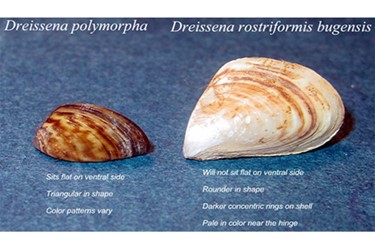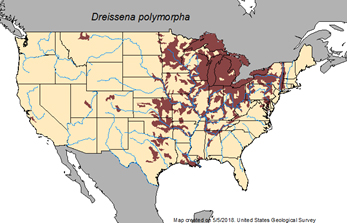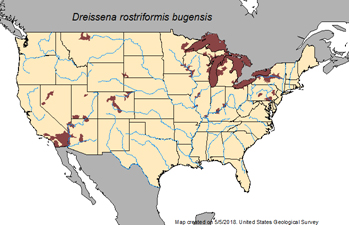West Coast WTPs: Beware Of Intruders On Your Doorstep


As if they don’t already face enough challenges, water treatment plants (WTPs) in the western U.S. have yet another potential problem lurking in their source water waiting to blossom when they least expect it. This specific problem comes in the form of two invasive species: quagga mussel (Dreissena rostriformis bugensis) and zebra mussels (Dreissena polymorpha). And even if a WTP has not yet experienced an infestation of these screen-, filter-, and pipeline-clogging pests, it does not mean that the possibility is not right around the corner.
The Nature And Scope Of The Problem
Occurrences of zebra mussels (Figure 1) in the U.S. have been documented in 32 states, including four Western states, since their initial appearance in the Great Lakes in 1986. Quagga mussels (Figure 2) have been documented in 18 states since their introduction in the Great Lakes in 1989, but 6 of those states are located within or west of the Rocky Mountain region.
Source: U.S. Geological Survey
Figure 1. Zebra mussels have had relatively few confirmed sightings in Western states, with several of those being only larval stage sightings without subsequent evidence of adult colonies.
Source: U.S. Geological Survey
Figure 2. Quagga mussel infestations are more concentrated across the U.S., but are already established in several Southern California reservoirs.
The two related species can be quite hardy and tolerant of a relatively wide range of environmental conditions — 33 to 84 degree water, current (up to 6 feet per second), low dissolved oxygen (down to 25 percent dissolved oxygen), and salinity (up to 5 parts per thousand). Under the right conditions (cool and damp), they can survive being out of water for several weeks. In their microscopic larval form, (called veligers), they can survive in any location that accumulates water — fishing boots, clothing, boat bilges and live wells, etc. These species are prolific breeders and can live from two to five years in favorable environments.
How Imminent Is The Problem?
The documented westward spread of these two invasive species — including scroll-down charts on their current status in specific watersheds — can be found in the following links and in the animated maps linked to Figures 1 and 2.
According to the U.S. Geological Service (USGS), adult quagga mussel populations are established at multiple locations in each of 12 waterways scattered across Southern California alone, with additional locations at 8 more waterways in Arizona, 5 in Colorado, 4 in Nevada, 3 in Utah, and 1 in Montana.
Less expansive, but equally disconcerting, is the fact that live adult zebra mussels have been confirmed as being “established” in two locations near Hollister, CA (the San Justo Reservoir and the Pajaro River Drainage). Zebra mussel larvae small enough to pass through most water intake grates have also been found in a few isolated cases in the Rocky Mountain states over the past decade. These include two cases in Colorado, one in Utah, and one in Montana.
The ecological impacts on other wildlife are bad enough — including crowding out native mussel species, colonizing on aquatic plants and animals, and disrupting the food chain by filtering out zooplankton, which support a variety of other aquatic life. The economic impacts on commercial operations such as power plants and water treatment plants can become extremely costly. The U.S. Department of the Interior spent $9.6 million addressing invasive mussels during the 2017 fiscal year, including establishing watercraft-decontamination-station educational materials and monitoring efforts. A 2012 study conducted by the Anderson Economic Group estimated the cost of invasive aquatic species to the Great Lakes region at significantly over $100 million annually, and the cost for zebra mussel control alone at municipal water treatment plants ranging from $350,000 to $540,000 per year.
Any water treatment plant operators who suspect that they might be experiencing a new impact from zebra or quagga mussels can visit the Aquatic Nuisance Species Taskforce website to identify an invasive species expert for their specific state.
What’s The Solution?
The recent U.S. EPA document Safeguarding the West from Invasive Species (February 2018) notes that there are currently “no practical methods for large-scale, open-water control of invasive mussel populations once they become established” in a new body of water.
According to a U.S. Fish and Wildlife Service fact sheet on zebra and quagga mussels, “a wide variety of chemical and mechanical control methods have been employed to combat zebra and quagga mussels (such as chlorine, ozone, water drawdowns, electric currents, UV radiation, heat, screens and filters, mechanical scraping, pressure washing and pipeline pigging), but most only provide temporary relief from problematic infestations.” Compounding that problem is the fact that some chemical treatments used to control these invasive mussels have the undesirable effect of killing other species in the same waterways.
Midwestern and Eastern state locations dealing with zebra/quagga mussel infestations are using a variety of the previously mentioned treatments in the attempt to keep water intakes and pipelines open. Newly developed coatings designed to prevent mussels from attaching to hard surfaces are also being used.
The Power Of Prevention
Given the difficulty of eradicating zebra and quagga mussel infestations once they are established, a primary method for delaying or minimizing impact from these invasive species is to prevent them from “hitchhiking” from one waterway to another in the first place. To that end, many state agencies have established strict rules for recreational boats being trailered from one waterway to another. States are enforcing inspections of trailered boats before launch and reserve the right to impound boats until they are cleaned.
That task is not without its challenges, however. Those two species are relentless. For example, the adult species that attach to hard-to-see areas of boats and trailers can survive long trips exposed to the open air. Worse yet, the larvae of these mussels are miniscule in size, and can go unnoticed in small pools of water inside of boat live wells and bilge areas.
Water utilities in as-of-yet unaffected areas can help to educate their customer base on the importance of stopping the spread of these invasive species when those customers travel to and from infested waters. They can emphasize the need to protect local waters from costly infestations and refer customers to websites such as the Aquatic Nuisance Species (NAS) Taskforce where they can access educational materials from groups such as the 100th Meridian Initiative and Stop Aquatic Hitchhikers.
In December of 2017, the U.S. Bureau of Reclamation floated the idea of offering a $100,000 prize for someone who could come up with a plan to top the advance of invasive mussel species such as quagga and zebra mussels. The multi-stage approach included a theoretical challenge calling for white papers on novel treatments, laboratory-scale proof-of-concept, and field-scale proof of treatments being cost-effective and scalable to large bodies of water.


